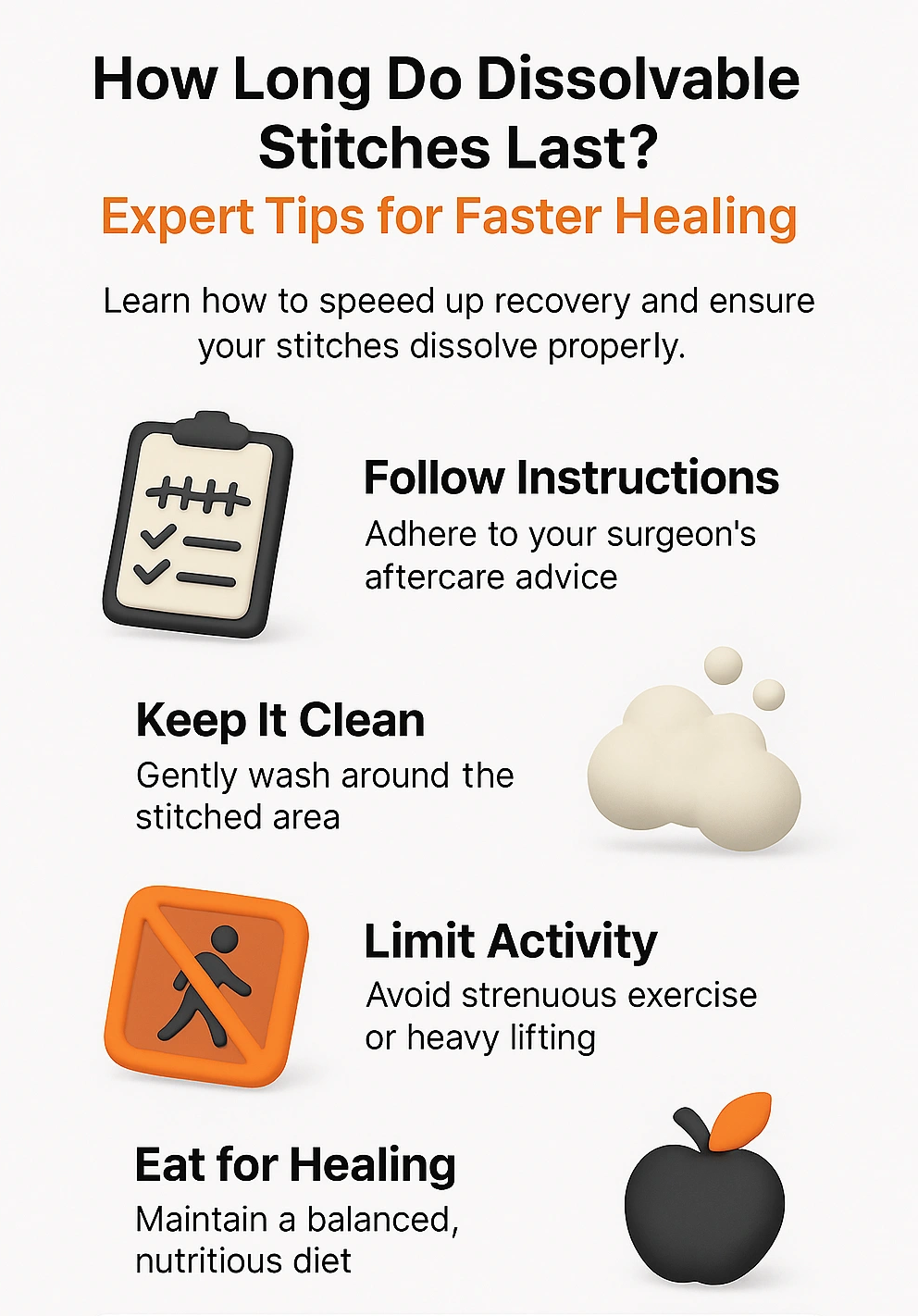How long do dissolvable stitches last? The answer isn’t the same for everyone. Drawing from patient experiences and medical expertise, these stitches can dissolve in just a few days or remain in place for months. Factors such as suture type, wound location, the body’s healing speed, and aftercare quality all play a role.
In this guide, we’ll walk through how long do dissolvable stitches last, the average lifespan of dissolvable stitches, why that timeline changes depending on the procedure, and what you can do to help them dissolve efficiently while healing safely.
Top Takeaways
- Most dissolvable stitches last 4–8 weeks, but timelines can be shorter or longer.
- Duration depends on material, wound site, activity, and aftercare habits.
- Good aftercare reduces complications and helps stitches dissolve as intended.
- Absorbable sutures are as safe as non-absorbable when chosen appropriately.
- Educated patients who follow care instructions often heal faster and better.
Lifespan of Dissolvable Stitches and What Affects It
Dissolvable stitches—also called absorbable sutures—are designed to break down naturally, meaning you won’t need to have them removed. Depending on the material and the wound’s location, they can last from 7 days up to 3 months.
- Fast-absorbing stitches (often used for surface closures) may dissolve within a week.
- Slow-absorbing stitches (commonly placed in deeper or high-tension areas) may remain for weeks or even months.
The breakdown process occurs as the body’s enzymes and immune system absorb the suture material. The better the wound is cared for—by keeping it clean, avoiding unnecessary strain, and following professional advice—the more likely the stitches will dissolve on schedule without issues.
“After observing countless patient recoveries, I’ve found that stitch longevity varies widely. Choosing the right suture material, placing it properly, and maintaining excellent aftercare are the key factors in ensuring both effective healing and timely absorption.”
Case Study & Real-World Examples
Fast Dissolution – Dental Surgery
- Patient: 34 years old, post-wisdom tooth extraction.
- Stitches dissolved in about 7 days due to high moisture and active enzymes in the mouth.
- Aftercare: Saltwater rinses and soft-food diet.
- Outcome: Smooth recovery without irritation.
Moderate Duration – Knee Arthroscopy
- Patient: 48 years old, avid runner.
- Stitches lasted about 6 weeks due to constant movement and mild swelling.
- Aftercare: Supportive taping and gradual return to activity.
- Outcome: Steady wound protection and progressive healing.
Slow Absorption – Abdominal Surgery
- Patient: 52 years old, with polydioxanone (PDS) sutures.
- Sutures held strength for roughly 8 weeks, fully dissolving at 3 months.
- Purpose: Provided extended support for deep tissue repair.
- Aftercare: Diligent cleaning and infection prevention.
Key Insight: Healing timelines vary based on suture type, wound environment, movement, and aftercare diligence.
Supporting Statistics
- Safety: Absorbable sutures are equally effective as non-absorbable in most cases (American Academy of Orthopaedic Surgeons).
- Best Practices: Proper hygiene, dressing changes, and wound monitoring promote optimal healing (Mayo Clinic).
Final Thought & Opinion
- Dissolvable stitches are tailored to your procedure and body’s needs.
- They may dissolve quickly or slowly—both can be normal.
- Patients who stay informed, follow aftercare advice, and maintain good health habits typically recover faster and with fewer complications.
Expert Tips for Faster Healing
- Follow your provider’s aftercare plan exactly.
- Keep the wound clean and dry unless otherwise instructed.
- Avoid excessive movement or strain on the affected area.
- Maintain a balanced diet rich in protein, vitamins, and minerals.
- Stay hydrated to support overall healing.
- Keep all follow-up appointments for wound assessment.
Frequently Asked Questions
How long do dissolvable stitches last?
Usually 4–8 weeks, but some dissolve in days while others last several months.
Can I make stitches dissolve faster?
You can’t speed up absorption, but you can avoid delays by following proper aftercare and preventing infection.
Why do timelines vary so much?
Factors include suture type, wound location, movement, and individual healing response.
What if my stitches haven’t dissolved when expected?
Contact your healthcare provider for evaluation—don’t remove them yourself.
What foods help stitches heal faster?
Protein-rich foods, fruits, vegetables, and hydration all help repair tissues and support healing.
When understanding How Long Do Dissolvable Stitches Last? Expert Tips for Faster Healing, it’s important to recognize how overall health and environment can influence recovery speed. Just as maintaining clean air in your home with products like the 14x24x2 Air Filters supports respiratory wellness, keeping your wound area clean and free from contaminants helps stitches dissolve as intended. Resources like HVAC Company Near Me emphasize routine maintenance to prevent hidden issues, much like following aftercare instructions prevents complications during healing. Using high-quality filtration, such as the 17x22x1 Pleated Furnace Filters or the 16x30x1 MERV 11 Pleated HVAC AC Furnace Air Filters (6-Pack), parallels the idea of creating an optimal healing environment for the body. Even marketplace options like Furnace Air Filters demonstrate the importance of consistency and quality—principles that also apply to caring for dissolvable stitches for smooth, timely recovery.







